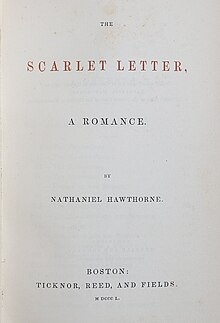Our website is made possible by displaying online advertisements to our visitors.
Please consider supporting us by disabling your ad blocker.
The Scarlet Letter
 Title page, first edition, 1850 | |
| Author | Nathaniel Hawthorne |
|---|---|
| Language | English |
| Genre | Romantic, Historical |
| Publisher | Ticknor, Reed & Fields |
Publication date | 16 March 1850[1] |
| Publication place | United States |
| 813.3 | |
| Text | The Scarlet Letter at Wikisource |
The Scarlet Letter: A Romance is a work of historical fiction by American author Nathaniel Hawthorne, published in 1850.[2] Set in the Puritan Massachusetts Bay Colony during the years 1642 to 1649, the novel tells the story of Hester Prynne, who conceives a daughter with a man to whom she is not married and then struggles to create a new life of repentance and dignity. As punishment, she must wear a scarlet letter 'A' (for "adultery"). Containing a number of religious and historic allusions, the book explores themes of legalism, sin and guilt.
The Scarlet Letter was one of the first mass-produced books in the United States. It was popular when first published[3] and is considered a classic work of American literature.[2] Commonly listed among the Great American Novels,[4] it has inspired numerous film, television, and stage adaptations. Critics have described The Scarlet Letter as a masterwork,[5] and novelist D. H. Lawrence called it a "perfect work of the American imagination".[6]
- ^ "On Saturday, March 16, Will Be Published, In One Volume, 16 mo, bound in cloth and paper, The Scarlet Letter, A Romance, By Nathaniel Hawthorne". Boston Evening Transcript. March 9, 1850. p. 3.
- ^ a b "The 100 best novels: No 16 – The Scarlet Letter by Nathaniel Hawthorne (1850)". The Guardian. 6 January 2014.
- ^ Cite error: The named reference
McFarland136was invoked but never defined (see the help page). - ^ Delbanco, Nicholas (February 21, 2014). "Review: 'The Dream of the Great American Novel' by Lawrence Buell". Chicago Tribune.
- ^ Seabrook, Andrea (March 2, 2008). "Sinner, Victim, Object, Winner". National Public Radio (NPR). (A quotation in the article refers to The Scarlet Letter as Hawthorne's "masterwork"; in the audio version, the novel is referred to as his "magnum opus".)
- ^ Miller, Edwin Haviland (1991). Salem is My Dwelling Place: A Life of Nathaniel Hawthorne. Iowa City: University of Iowa Press. ISBN 0-87745-332-2.
Previous Page Next Page


